Spanish colonization of the Americas
The Spanish colonization of the Americas began in 1493 on the Caribbean island of Hispaniola (now Haiti and the Dominican Republic) after the initial 1492 voyage of Genoese mariner Christopher Columbus under license from Queen Isabella I of Castile.The expansion of Spain's territory took place under the Catholic Monarchs Isabella I of Castile and her husband Ferdinand II of Aragon, whose marriage marked the beginning of Spanish power beyond the Iberian Peninsula.Having departed from the port of Palos de la Frontera on 3 August 1492, on 12 October 1492, Genoese mariner Christopher Columbus and his crew made landfall in the Western Hemisphere, and in 1493 permanent Spanish settlement of the Americas began.Pope Alexander VI in a 4 May 1493 papal decree, Inter caetera, divided rights to lands in the Western Hemisphere between Spain and Portugal on the proviso that they spread Christianity.Spanish settlers initially found relatively dense populations of indigenous peoples, who were agriculturalists living in villages ruled by leaders not part of a larger integrated political system.[17] Las Casas spent his long life attempting to defend the indigenous populations and to enlist the Spanish crown in establishing protections for them, seen most prominently in the enactment of the New Laws of 1542, restricting Spaniards' inheritance of encomiendas.Cumaná in Venezuela was the first permanent settlement founded by Europeans in the mainland Americas,[18] in 1501 by Franciscan friars, but due to successful attacks by the indigenous people, it had to be refounded several times, until Diego Hernández de Serpa's foundation in 1569.Records of the conquest of central Mexico include accounts by the expedition leader Hernán Cortés, Bernal Díaz del Castillo and other Spanish conquistadors, indigenous allies from the city-states altepetl of Tlaxcala, Texcoco, and Huexotzinco.In 1532 at the Battle of Cajamarca a group of Spaniards under Francisco Pizarro and their indigenous Andean Indian auxiliaries native allies ambushed and captured the Emperor Atahualpa of the Inca Empire.The Spanish took advantage of a recent civil war between the factions of the two brothers Emperor Atahualpa and Huáscar, and the enmity of indigenous nations the Incas had subjugated, such as the Huanca, Chachapoyas, and Cañaris.Spanish explorers claimed land for the crown in the modern-day states of Alabama, Arizona, the Carolinas, Colorado, Florida, Georgia, Mississippi, New Mexico, Texas, and California.They preferred wheat cultivation to indigenous sources of carbohydrates: casava, maize (corn), and potatoes, initially importing seeds from Europe and planting in areas where plow agriculture could be utilized, such as the Mexican Bajío.[citation needed] The empire in the Indies was a newly established dependency of the kingdom of Castile alone, so crown power was not impeded by any existing cortes (i.e. parliament), administrative or ecclesiastical institution, or seigneurial group.The crown asserted is authority and sovereignty of the territory and vassals it claimed, collected taxes, maintained public order, meted out justice, and established policies for governance of large indigenous populations.The officials of the royal treasury at each level of government typically included two to four positions: a tesorero (treasurer), the senior official who guarded money on hand and made payments; a contador (accountant or comptroller), who recorded income and payments, maintained records, and interpreted royal instructions; a factor, who guarded weapons and supplies belonging to the king, and disposed of tribute collected in the province; and a veedor (overseer), who was responsible for contacts with native inhabitants of the province, and collected the king's share of any war booty.Held in the Colegio de San Gregorio, in the Spanish city of Valladolid, it was a moral and theological debate about the colonization of the Americas, its justification for the conversion to Catholicism and more specifically about the relations between the European settlers and the natives of the New World.According to the French historian Jean Dumont The Valladolid debate was a major turning point in world history "In that moment in Spain appeared the dawn of the human rights".Since in Mesoamerica and the Andean civilizations, indigenous peoples had existing traditions of payment of tribute and required labor service, the Spanish could tap into these systems to extract wealth.As the indigenous populations declined, the need for corregimiento decreased and then suppressed, with the alcaldía mayor remaining an institution until it was replaced in the eighteenth-century Bourbon Reforms by royal officials, Intendants.The salary of officials during the Habsburg era were paltry, but the corregidor or alcalde mayor in densely populated areas of indigenous settlement with a valuable product could use his office for personal enrichment.[127] Most Spanish settlers came to the Indies as permanent residents, established families and businesses, and sought advancement in the colonial system, such as membership of cabildos, so that they were in the hands of local, American-born (crillo) elites.[128] As the empire expanded into areas of less dense indigenous populations, the crown created a chain of presidios, military forts or garrisons, that provided Spanish settlers protection from Indian attacks.Although their primary focus was on religious conversion, missionaries served as "diplomatic agents, peace emissaries to hostile tribes ... and they were also expected to hold the line against nomadic nonmissionary Indians as well as other European powers.[106] During the early colonial period, the crown authorized friars of Catholic religious orders (Franciscans, Dominicans, and Augustinians) to function as priests during the conversion of indigenous populations.During the early Age of Discovery, the diocesan clergy in Spain was poorly educated and considered of a low moral standing, and the Catholic Monarchs were reluctant to allow them to spearhead evangelization.Although implementation was slow and incomplete, it was an assertion of royal power over the clergy and the quality of parish priests improved, since the Ordenanza mandated competitive examination to fill vacant positions.In Mexico, Bishop Juan de Zumárraga prosecuted and had executed in 1539 a Nahua lord, known as Don Carlos of Texcoco for apostasy and sedition for having converted to Christianity and then renounced his conversion and urged others to do so as well.Cane sugar imported from the Old World was a high value, a low bulk export product that became the bulwark of tropical economies of the Caribbean islands and coastal Tierra Firme (the Spanish Main), as well as Portuguese Brazil.Large deposits were found in a single mountain in the viceroyalty of Peru, the Cerro Rico, in what is now Bolivia, and in several places outside of the dense indigenous zone of settlement in northern Mexico, Zacatecas and Guanajuato.[149][150][151] To feed urban populations and mining workforces, small-scale farms (ranchos), (estancias), and large-scale enterprises (haciendas) emerged to fill the demand, especially for foodstuffs that Spaniards wanted to eat, most especially wheat.



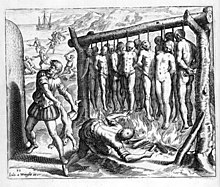
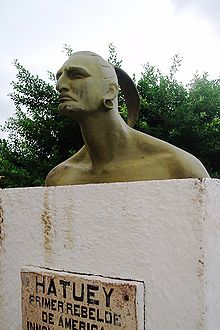
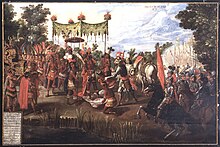




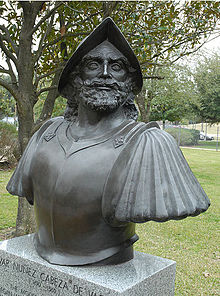




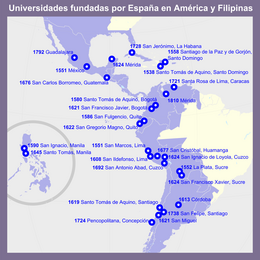








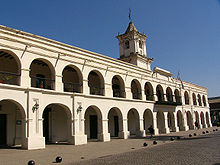


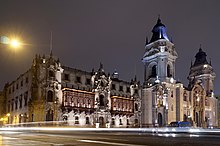


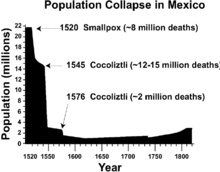


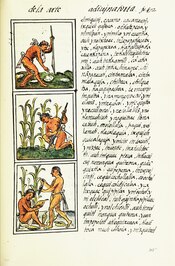
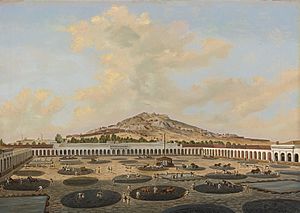

Development of Spanish American Independence
Government under traditional Spanish law
Loyal to Supreme Central Junta or Cortes
American junta or insurrection movement
Independent state declared or established
Height of French control of the Peninsula

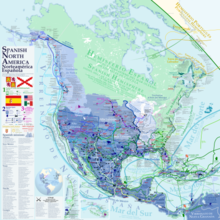
Conquista (disambiguation)conquistadorscrown of CastileHernán CortésFrancisco PizarroPortugueseEuropean colonizationof the AmericasFirst waveBasqueBritishScottishCuronianDanishFrenchGermanHospitallerItalianRussianSwedishColonization of CanadaColonization of the United StatesDecolonizationHispaniolaGenoeseChristopher ColumbusIsabella I of CastileSpanish Empireindigenous peoplesCatholic Churchvaluable resources for extractionTreaty of TordesillasBourbon dynastythe spread of infectious diseasesforced labor and slaverynew villagesmissionsSpanish American wars of independencePuerto RicoPhilippinesSpanish–American WarFerdinand II of AragonIberian PeninsulaSpanish monarchyEmirate of GranadaReconquestPalos de la FronteraKingdom of PortugalPope Alexander VIInter caeteraCharles VThe empire on which the sun never setsPhilip IIPhilippine IslandsJohann Moritz Rugendassoldiers of fortuneadelantadoconquest of the Aztec Empireconquest of the IncaAztec Empirecity-stateTlaxcalaHistory of the CaribbeanTheodor de BryLas Casas'A Short Account of the Destruction of the Indiescannibalismindigenous peoples of the AmericasWest IndiesLa NavidadLa IsabelaDominican Republicconquest of HispaniolaHatueyTaínosencomiendaJamaicaEnriquilloAntonio de MontesinosBartolomé de las CasasBlack LegendNew LawsNueva CádizCubaguaAlonso de OjedaGuajira PeninsulaCumanáFranciscanfriarsDiego Hernández de SerpaSanta María la Antigua del DariénFrancisco Hernández de CórdobaJuan de GrijalvaSt-DomingueSpanish conquest of the Aztec EmpireBernal Díaz del CastilloaltepetlTexcocoTenochtitlanMoctezuma IIPedro de AlvaradoSpanish conquest of YucatánSpanish conquest of GuatemalaPurépechawar of Mexico's westChichimeca Warconquest of the Incan EmpireSpanish conquest of the Inca EmpireViceroyalty of PeruJohn Everett MillaisBattle of CajamarcaIndian auxiliariesAtahualpaInca EmpireInca civilizationHuáscarHuancaChachapoyasCañarislast Inca strongholdConquest of ChileColonial ChileSpanish colonization attempt of the Strait of MagellanFirst relation letter from Pedro de Valdivia to emperor Charles Vmild climateMapucheAraucanians
